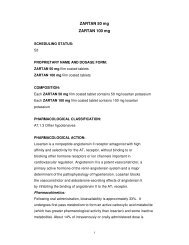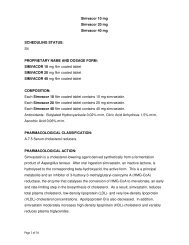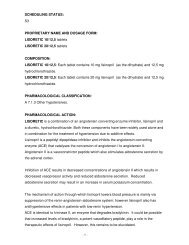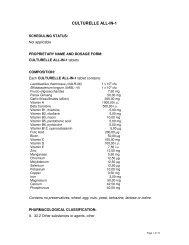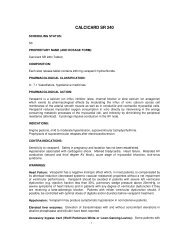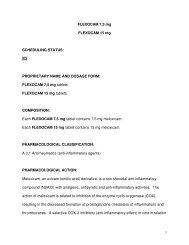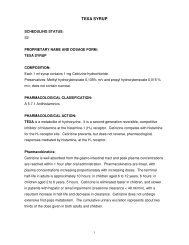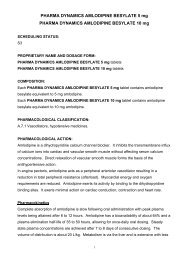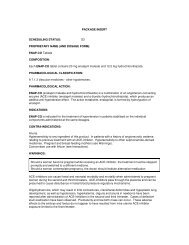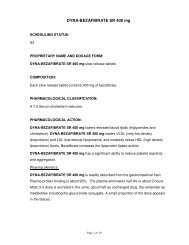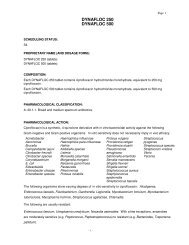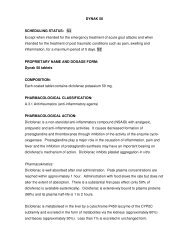Bilocor 5 Bilocor 10 - Pharma Dynamics
Bilocor 5 Bilocor 10 - Pharma Dynamics
Bilocor 5 Bilocor 10 - Pharma Dynamics
You also want an ePaper? Increase the reach of your titles
YUMPU automatically turns print PDFs into web optimized ePapers that Google loves.
SCHEDULING STATUS:<br />
S3<br />
PROPRIETARY NAME AND DOSAGE FORM:<br />
BILOCOR 5 TABLETS<br />
BILOCOR <strong>10</strong> TABLETS<br />
COMPOSITION:<br />
<strong>Bilocor</strong> 5<br />
<strong>Bilocor</strong> <strong>10</strong><br />
Each BILOCOR 5 tablet contains 5 mg bisoprolol fumarate<br />
Each BILOCOR <strong>10</strong> tablet contains <strong>10</strong> mg bisoprolol fumarate.<br />
PHARMACOLOGICAL CLASSIFICATION:<br />
A 5.2 Adrenolytics (sympatholytics).<br />
PHARMACOLOGICAL ACTION:<br />
Bisoprolol is a selective β1-adrenoceptor antagonist devoid of intrinsic sympathomimetic and<br />
membrane-stabilising activity.<br />
<strong>Pharma</strong>cokinetics:<br />
Bisoprolol is well absorbed following oral administration with a resultant bioavailability of about<br />
90%. Bisoprolol undergoes minimal hepatic first-pass metabolism. About 50% of a dose is<br />
metabolised in the liver and the remainder is excreted unchanged via the kidneys. The plasma<br />
elimination half-life is approximately <strong>10</strong> to 12 hours and the duration of action is about 24 hours.<br />
INDICATIONS:<br />
BILOCOR is indicated for the management of mild to moderate hypertension and angina<br />
pectoris.<br />
CONTRA-INDICATIONS:<br />
• Hypersensitivity to bisoprolol or to any of the ingredients<br />
- 1 -
• Uncontrolled asthma<br />
• Second and third-degree heart block and bradycardia (less than 50 beats per minute)<br />
• Pregnancy and lactation<br />
• Uncontrolled cardiac failure<br />
• Metabolic acidosis<br />
• Sinus bradycardia (less than 50 beats per minute)<br />
• Phaeochromocytoma<br />
• Hyperthyroidism, as clinical manifestations may be masked.<br />
Particular caution should be exercised with patients suffering from the following: asthma,<br />
bronchitis, chronic respiratory diseases, peripheral vascular diseases and Raynaud’s<br />
phenomenon.<br />
The normal dose should be reduced in elderly patients, or in patients suffering from renal<br />
dysfunction. In the perioperative period it is generally unwise to reduce the dosage to which the<br />
patient is accustomed, as there may be danger of aggravation of angina pectoris or<br />
hypertension. A patient’s normal tachycardiac response to hypovolaemia or blood loss may be<br />
obscured during or after surgery. Particular caution should be taken in this regard and in<br />
diabetes mellitus, as symptoms and signs of hypoglycaemia may be masked, and as responses<br />
to hypoglycaemia is diminished.<br />
WARNINGS:<br />
Safety and efficacy in children have not been established.<br />
If the decision is made to withdraw BILOCOR before anaesthesia, at least 48 hours should be<br />
allowed to elapse between the last dose and surgery. If the medicine is to be continued, care<br />
should be taken when using anaesthetics such as ether, cyclopropane and trichloroethylene.<br />
Atropine (1-2 mg I.V.) may be used to correct vagal dominance. The patient must be maintained<br />
on their usual dosage perioperatively to avoid aggravation of angina pectoris or hypertension.<br />
Tachycardia responses may be obscured. Particular caution should be taken in this regard.<br />
- 2 -
The dosage of BILOCOR should be adjusted in severe renal impairment. (See DOSAGE AND<br />
DIRECTIONS FOR USE).<br />
Care should be taken in prescribing BILOCOR together with Class 1 antidysrhythmic agents<br />
such as disopyramide, myocardial depressants and inhibitors of AV conduction such as calcium<br />
antagonists.<br />
Caution should be exercised when transferring a patient from clonidine, as the withdrawal of<br />
clonidine may result in the release of large amounts of catecholamines that may give rise to a<br />
hypertensive crisis. If BILOCOR is administered in these circumstances, the unopposed alpha-<br />
receptor stimulation may potentiate this effect. If BILOCOR and clonidine are given<br />
concurrently, the clonidine should not be discontinued until several days after the withdrawal of<br />
BILOCOR as severe rebound hypertension may occur.<br />
BILOCOR should be used with caution in combination with verapamil in patients with impaired<br />
ventricular function. This combination should not be given to patients with conduction<br />
abnormalities. Neither drug should be administered intravenously within 48 hours of<br />
discontinuing the other. The intravenous administration of calcium antagonists and<br />
antiarrhythmic agents is not recommended during therapy with BILOCOR.<br />
BILOCOR modifies the tachycardia associated with hypoglycaemia.<br />
Patients with phaeochromocytoma usually require treatment with an alpha-adrenergic blocker.<br />
INTERACTIONS:<br />
• Concomitant use of BILOCOR with hypoglycaemic agents, phenothiazines and various<br />
antiarrhythmic agents can have life-threatening consequences, e.g.<br />
• profound hypoglycaemia with oral hypoglycaemic agents and insulin;<br />
• myocardial depression with antiarrhythmic agents.<br />
• Beta-adrenoceptor stimulating agents (e.g. isoprenaline) may antagonise the effects of<br />
BILOCOR.<br />
- 3 -
• Alpha-adrenoceptor stimulants as well as adrenergic neurone blocking agents such as<br />
guanethidine and reserpine may lead to life-threatening vasoconstriction in combination<br />
with BILOCOR.<br />
• BILOCOR and digoxin may be used concomitantly for patients with congestive heart<br />
failure provided that the pulse rate and patient response is monitored.<br />
PREGNANCY AND LACTATION:<br />
Administration of BILOCOR to pregnant mothers shortly before birth or during labour may result<br />
in hypotonia, collapse or hypoglycaemia in the newborn. (See CONTRA-INDICATIONS).<br />
DOSAGE AND DIRECTIONS FOR USE:<br />
Adults: 5 to <strong>10</strong> mg once a day in the morning with or without food. The dose must be<br />
individualised according to response and tolerance. The maximum recommended daily dose is<br />
20 mg daily.<br />
Severe renal impairment (creatinine clearance
Central nervous system:<br />
Lassitude, dizziness, mild headache, sleep disorders, restlessness, cold extremities,<br />
hypotension, paradoxical hypertension, depression, paraesthesia, hallucinations, psychosis.<br />
Endocrine/Metabolic:<br />
Metabolic disturbances, hypoglycaemia, increase in uric acid levels, hypercholesterolaemia.<br />
Gastrointestinal:<br />
Nausea, vomiting, diarrhoea, constipation, mass gain, stomatitis.<br />
Liver:<br />
Raised liver enzymes.<br />
Musculoskeletal:<br />
Muscle cramps, myopathy, skeletal muscle weakness.<br />
Ocular:<br />
Disturbances of vision.<br />
Skin:<br />
Perspiration, skin rash, alopecia.<br />
Other:<br />
Transient hearing loss, hypersensitivity reactions, sexual impotence.<br />
Respiratory system disorders:<br />
Bronchoconstriction may occur in patients suffering from asthma, bronchitis and other chronic<br />
pulmonary diseases.<br />
Adverse reactions are more common in patients with renal decompensation.<br />
Special Precautions:<br />
Abrupt discontinuation of therapy may cause exacerbation of angina pectoris in patients<br />
suffering from ischaemic heart disease. Discontinuation of therapy should be gradual, and<br />
- 5 -
patients should be advised to limit the extent of their physical activity during the period that the<br />
medicine is being discontinued.<br />
KNOWN SYMPTOMS OF OVERDOSAGE AND PARTICULARS OF ITS TREATMENT:<br />
(See SIDE-EFFECTS AND SPECIAL PRECAUTIONS)<br />
Overdosage may produce bradycardia and severe hypotension. Bronchospasm and heart<br />
failure may be produced in certain individuals.<br />
Cases of overdose should be observed for at least 4 hours, as apnoea and cardiovascular<br />
collapse may appear suddenly.<br />
Repeated activated charcoal may be necessary in overdose.<br />
Atropine may be used to treat severe bradycardia. If the response is inadequate, glucagon may<br />
be given intravenously. Alternatively, dobutamine may be required to reverse beta-blockade.<br />
Cardiac pacing may be required for severe bradycardia. Bronchospasm should be treated with<br />
IV aminophylline or inhaled or IV beta-agonist e.g. salbutamol.<br />
IDENTIFICATION:<br />
BILOCOR 5: Pale yellow, mottled, round normal convex tablet embossed with BI over break-line and<br />
5 on one side and plain on the reverse.<br />
BILOCOR <strong>10</strong>: Mottled dark beige, round normal convex tablet embossed with BI over break-line and<br />
<strong>10</strong> on one side and plain on the reverse.<br />
PRESENTATION:<br />
Opaque or clear Al/PVC/PVdC blister packs containing 30 tablets.<br />
STORAGE INSTRUCTIONS:<br />
Store below 25°C in well-closed containers. Protect from light.<br />
Keep blister packs in carton until required for use.<br />
KEEP OUT OF REACH OF CHILDREN.<br />
- 6 -
REGISTRATION NUMBERS:<br />
BILOCOR 5: 38/5.2/0053<br />
BILOCOR <strong>10</strong>: 38/5.2/0051<br />
NAME AND BUSINESS ADDRESS OF THE HOLDER OF THE CERTIFICATE OF<br />
REGISTRATION:<br />
<strong>Pharma</strong> <strong>Dynamics</strong> (Pty) Ltd<br />
F02 Grapevine House<br />
Steenberg Office Park<br />
Westlake<br />
7945<br />
DATE OF PUBLICATION OF THE PACKAGE INSERT:<br />
12 August 2004<br />
- 7 -
SKEDULERINGSTATUS:<br />
S3<br />
EIENDOMSNAAM EN DOSEERVORM:<br />
BILOCOR 5 TABLETTE<br />
BILOCOR <strong>10</strong> TABLETTE<br />
SAMESTELLING:<br />
<strong>Bilocor</strong> 5<br />
<strong>Bilocor</strong> <strong>10</strong><br />
Elke BILOCOR 5 tablet bevat 5 mg bisoprololfumaraat.<br />
Elke BILOCOR <strong>10</strong> tablet bevat <strong>10</strong> mg bisoprololfumaraat.<br />
FARMAKOLOGIESE KLASSIFIKASIE:<br />
A 5.2 Adrenolitika (simpatolitika)<br />
FARMAKOLOGIESE WERKING:<br />
Bisoprolol is ‘n selektiewe β-1-adrenoseptorantagonis sonder intrinsieke simpatomimetiese en<br />
membraanstabiliserende aktiwiteit.<br />
Farmakokinetika:<br />
Bisoprolol word na orale toediening goed geabsorbeer met ‘n biobeskikbaarheid van ongeveer<br />
90%. Bisoprolol ondergaan minimale eerstedeurgangsmetabolisme in die lewer. Ongeveer<br />
50% van ‘n dosis word in die lewer gemetaboliseer en die res word onveranderd deur die niere<br />
uitgeskei. Die eliminasiehalfleeftyd vanuit die plasma is ongeveer <strong>10</strong> tot 12 uur en die duur van<br />
werking is ongeveer 24 uur.<br />
INDIKASIES:<br />
BILOCOR is aangedui vir die beheer van ligte tot matige hipertensie en angina pectoris.<br />
KONTRA-INDIKASIES:<br />
• Hipersensitiwiteit teenoor bisoprolol of teenoor enige van die bestanddele<br />
- 8 -
• Ongekontroleerde asma<br />
• Tweede- en derdegraadse hartblok en bradikardie (minder as 50 slae per minuut)<br />
• Swangerskap en laktasie<br />
• Onbeheerde hartversaking<br />
• Metaboliese asidose<br />
• Sinusbradikardie (minder as 50 slae per minuut)<br />
• Feochromositoom<br />
• Hipertiroïedisme omdat kliniese tekens maskeer kan word<br />
Wees besonder versigtig met pasiënte wat aan die volgende ly: asma, brongitis, chroniese<br />
respiratoriese siekte, perifere vaskulêre siekte en Raynaud se verskynsel.<br />
Die normale dosis moet verminder word vir bejaarde pasiënte of pasiënte wat aan nierdisfunksie<br />
ly. In die peri-operatiewe periode is dit oor die algemeen onwys om die dosis waaraan die<br />
pasiënt gewoond is te verminder omdat die gevaar bestaan dat angina pectoris of hipertensie<br />
kan vererger. Die pasiënt se normale tagikardiale respons op hipovolemie of bloedverlies<br />
tydens of na die operasie kan verberg word. Wees besonder versigtig hiervoor asook met<br />
diabetes mellitus omdat simptome en tekens van hipoglisemie maskeer kan word omdat die<br />
respons teenoor hipoglisemie minder is.<br />
WAARSKUWINGS:<br />
Die veiligheid en effektiwiteit in kinders is nie bepaal nie.<br />
As besluit word om BILOCOR voor narkose te onttrek, moet ten minste 48 uur tussen die laaste<br />
dosis en die operasie verloop. As die medisyne voortgesit moet word, moet anestetika soos<br />
eter, siklopropaan of trichlooretileen versigtig gebruik word. Atropien (1-2 mg IV) kan gebruik<br />
word om vagale dominansie reg te stel. Die pasiënt moet tydens die operasie op die gewone<br />
dosis gehou word om verergering van angina pectoris of hipertensie te voorkom.<br />
Tagikardiale respons kan verberg word. Wees besonder versigtig hiervoor.<br />
Die dosis van BILOCOR moet aangepas word vir pasiënte met ernstige swak nierfunksie (kyk<br />
DOSIS EN GEBRUIKSAANWYSINGS).<br />
- 9 -
Wees versigtig as BILOCOR saam met Klas 1 antidisritmiese middels, soos disopiramied,<br />
miokardiale onderdrukkers, en remmers van AV-geleiding, soos kalsiumantagoniste,<br />
voorgeskryf word.<br />
Wees versigtig wanneer ‘n pasiënt van klonidien af oorgeskakel word omdat die onttrekking van<br />
klonidien tot die vrystelling van groot hoeveelhede katesjolamiene kan lei wat ‘n hipertensiewe<br />
krisis kan veroorsaak. As BILOCOR onder hierdie omstandighede toegedien word, kan die<br />
ongeopponeerde stimulasie van alfa-reseptore hierdie effek versterk. As BILOCOR en klonidien<br />
saam gegee word, moet die klonidien nie gestaak word tot etlike dae na onttrekking van<br />
BILOCOR nie omdat erge terugslaghipertensie kan voorkom.<br />
BILOCOR in kombinasie met verapamiel moet versigtig gebruik word vir pasiënte met swak<br />
ventrikulêre funksie. Hierdie kombinasie moet nie aan pasiënte met abnormaliteite in geleiding<br />
gegee word nie. Nie een van die middels moet binne 48 uur na staking van die ander een<br />
intraveneus toegedien word nie. Die intraveneuse toediening van kalsiumantagoniste en anti-<br />
aritmiese middels tydens behandeling met BILOCOR word nie aanbeveel nie.<br />
BILOCOR modifiseer die tagikardie wat met hipoglisemie gepaardgaan.<br />
Pasiënte met feochromositoom het gewoonlik behandeling met ‘n alfa-adrenergiese blokkeerder<br />
nodig.<br />
INTERAKSIES:<br />
• Gelyktydige gebruik vir BILOCOR en hipoglisemiese middels, fenotiasiene en verskeie<br />
anti-aritmiese middels kan lewensbedreigende gevolge hê, soos<br />
• Uitgesproke hipoglisemie met orale hipoglisemiese middels en insulien<br />
• Miokardiale onderdrukking deur anti-aritmiese middels.<br />
• Beta-adrenoseptor stimulerende middels (bv. isoprenalien) kan die effekte van BILOCOR<br />
antagoneer.<br />
• Alfa-adrenoseptorstimulante asook adrenergiese neuronblokkeerders soos guanetidien en<br />
reserpien saam met BILOCOR kan tot lewensbedreigende vasokonstriksie lei.<br />
- <strong>10</strong> -
• BILOCOR en digoksien kan gelyktydig gebruik word vir pasiënte met kongestiewe<br />
hartversaking op voorwaarde dat die polsslag en die respons van die pasiënt gemonitor<br />
word.<br />
SWANGERSKAP EN LAKTASIE:<br />
Toediening van BILOCOR aan swanger moeders kort voor of tydens die bevalling kan tot<br />
hipotonie, ineenstorting of hipoglisemie in die pasgeborene lei (kyk KONTRA-INDIKASIES).<br />
DOSIS EN GEBRUIKSAANWYSINGS:<br />
Volwassenes: 5 tot <strong>10</strong> mg een keer per dag in die oggend met of sonder voedsel. Die dosis<br />
moet volgens die respons en verdraagbaarheid vir elke individu aangepas word. Die maksimum<br />
aanbevole daaglikse dosis is 20 mg per dag.<br />
Ernstige swak nierfunksie (kreatinienopruiming < 20 ml/min) of ernstige swak<br />
lewerfunksie:<br />
Die daaglikse dosis van <strong>10</strong> mg moet nie oorskry word nie.<br />
Bejaardes:<br />
Die normale dosis moet vir hierdie pasiënte verminder word.<br />
NEWE-EFFEKTE EN SPESIALE VOORSORGMAATREËLS:<br />
Newe-effekte:<br />
Hematologies:<br />
Bloedversteurings soos leukopenie en trombositopenie.<br />
Kardiovaskulêre stelsel:<br />
Bradikardie en kongestiewe hartversaking, hartblok, vloeistofretensie, verergering van perifere<br />
vaskulêre siekte of die ontwikkeling van Raynaud se verskynsel en perifere gangreen kan<br />
aangebring word. Kongestiewe hartversaking en uitgesproke bradikardie kan voorkom.<br />
Sentrale senustelsel:<br />
Lusteloosheid, duiseligheid, ligte hoofpyn, slaapversteurings, rusteloosheid, koue ekstremiteite,<br />
hipotensie, paradoksale hipertensie, depressie, parestesie, hallusinasies, psigose.<br />
- 11 -
Endokrien/Metabolies:<br />
Metaboliese versteurings, hipoglisemie, toename in vlakke van uriensuur, hipercholesterolemie.<br />
Gastro-intestinaal:<br />
Naarheid, braking, diarree, hardlywigheid, gewigstoename, stomatitis.<br />
Lewer:<br />
Toename in lewerensieme.<br />
Muskuloskeletaal:<br />
Spierkrampe, miopatie, swakheid van skeletspiere.<br />
Okulêr:<br />
Steurings in visie.<br />
Vel:<br />
Sweet, veluitslag, alopesie.<br />
Ander:<br />
Tydelike gehoorverlies, hipersensitiwiteitsreaksies, seksuele impotensie.<br />
Versteurings van asemhalingstelsel:<br />
Brongokonstriksie kan voorkom in pasiënte wat aan asma, brongitis en ander chroniese<br />
longsiektes ly.<br />
Nadelige reaksies is meer algemeen in pasiënte met swak nierfunksie.<br />
Spesiale voorsorgmaatreëls:<br />
Skielike staking van behandeling kan ‘n verergering van angina pectoris veroorsaak in pasiënte<br />
wat aan isgemiese hartsiekte ly. Staking van behandeling moet geleidelik wees en pasiënte<br />
moet aangeraai word om die mate van hulle fisiese aktiwiteit te beperk in die periode<br />
waartydens die medisyne gestaak word.<br />
- 12 -
BEKENDE SIMPTOME VAN OORDOSERING EN BESONDERHEDE VIR DIE BEHANDELING<br />
DAARVAN<br />
(kyk NEWE-EFFEKTE EN SPESIALE VOORSORGMAATREËLS):<br />
Oordosering kan bradikardie en erge hipotensie veroorsaak. Brongospasma en hartversaking<br />
kan in sekere individue voorkom.<br />
Gevalle van oordosering moet vir ten minste 4 uur dopgehou word omdat apnee en kardio-<br />
vaskulêre ineenstorting skielik kan voorkom.<br />
Dit kan nodig wees om geaktiveerde koolstof herhaaldelik tydens oordosering toe te dien.<br />
Atropien kan gebruik word om erge bradikardie te behandel. As die respons nie voldoende is<br />
nie, kan glukagon intraveneus toegedien word. As alternatief kan dopamien gebruik word om<br />
beta-blokkade om te keer. Tydens erge bradikardie kan dit nodig wees om vir die hart pas aan<br />
te gee. Brongospasma moet met intraveneuse aminofillien of ingeasemde of intraveneuse beta-<br />
antagoniste, bv. salbutamol, behandel word.<br />
IDENTIFIKASIE:<br />
BILOCOR 5: Liggeel, gespikkelde, ronde, normale konvekse tablet met BI bo ‘n breeklyn en 5<br />
op die een kant gedruk en die ander kant skoon.<br />
BILOCOR <strong>10</strong>: Gespikkelde, donker beige, ronde, normale konvekse tablet met BI bo ‘n<br />
AANBIEDING:<br />
breeklyn en <strong>10</strong> op die een kant gedruk en die ander kant skoon.<br />
Ondeursigtige of helder Al/PVC/PVdC-stulppakke met 30 tablette.<br />
BEWARINGSINSTRUKSIES:<br />
Bewaar onder 25°C in diggeslote houers. Beskerm teen lig.<br />
Hou die stulppakke in die karton totdat hulle benodig word.<br />
HOU BUITE BEREIK VAN KINDERS.<br />
- 13 -
REGISTRASIENOMMERS:<br />
BILOCOR 5: 38/5.2/0053<br />
BILOCOR <strong>10</strong>: 38/5.2/0051<br />
NAAM EN BESIGHEIDSADRES VAN DIE HOUER VAN DIE REGISTRASIESERTIFIKAAT:<br />
<strong>Pharma</strong> <strong>Dynamics</strong> (Edms) Bpk<br />
F02 Grapevine House<br />
Steenberg Office Park<br />
Westlake<br />
7945<br />
DATUM VAN PUBLIKASIE VAN HIERDIE VOUBILJET:<br />
12 Augustus 2004<br />
- 14 -



